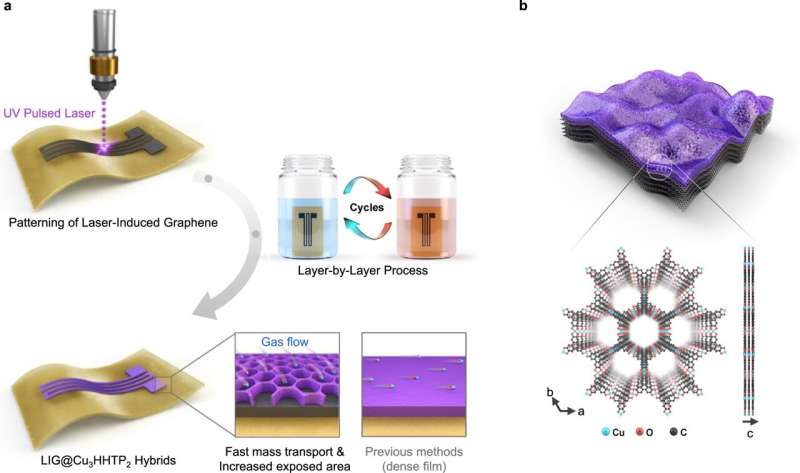This article has been reviewed according to Science X's editorial process and policies. Editors have highlighted the following attributes while ensuring the content's credibility:
fact-checked
peer-reviewed publication
proofread
Human lung-inspired sensor monitors nitrogen dioxide in real-time

A research team has developed a human lung-inspired graphene-metal organic framework hybrid gas sensor, which can monitor extremely low concentrations of nitrogen dioxide at the level of one billionth in real-time. This study was published online on May 30, 2023 in Nature Communications.
As a high-performance sensor, it is expected to be applied to health care devices owing to its simple manufacturing process, good energy efficiency, and flexibility.
Nitrogen dioxide, one of the major contributors to fine dust, is a hazardous substance that can potentially cause cardiovascular diseases and degenerative brain diseases. To keep nitrogen dioxide under control, it is crucial to develop a sensor that can monitor its concentrations. The performance of a nitrogen dioxide sensor is determined by how low its "detection limit" is and how quickly the sensor can detect the compound's concentration.
Traditional monitoring for nitrogen dioxide is mainly conducted in chemiluminescent stations, which are large in volume, expensive, and limited in terms of spatial measurement coverage. Therefore, the stations cannot provide personalized air pollution information. While semiconductor sensors could be an alternative, the commercialization of these sensors is limited as they not only fail to meet detection limit standards but also require high operating temperatures.
To overcome these limitations, a research team led by Professor Kwon successfully fabricated a hybrid structure that selectively grows a metal-organic framework (MOF) with extremely high nano-porosity on the substructure of laser-induced graphene (LIG), capable of covering a surface area as large as a soccer field with only 1g, and developed a sensor that can monitor extremely low concentrations of nitrogen dioxide in real-time.
More importantly, the sensor developed by the research team has a hierarchical pore structure, which is inspired by the human lung. The structure has its advantages not only in its great surface area but also in its fast gas exchanges. Consequently, the team successfully achieved the lowest detection limit (0.168 ppb) and the fastest response time (15 sec) compared to conventional nitrogen dioxide sensors.
Moreover, as the hybrid sensor, developed in this study, was based on the laser process, the research team easily manufactured electrodes without complex infrastructure, such as vacuum equipment, and simultaneously, solved the difficulty of patterning the MOF, which was not available previously. In addition, the gas sensor's flexible structure, which can maintain its performance even if bent up to 10,000 times, is expected to be applied to wearable high-performance healthcare devices.
The study's first author is Hyeong-tae Lim, a student in a combined Master's and Ph.D. program, and the research was led by Professor Hyuk-jun Kwon at the Department of Electrical Engineering and Computer Science of the Daegu Gyeongbuk Institute of Science & Technology (DGIST).
"We got inspiration from the human lung and developed a sensor that can protect people from air pollution caused by rapid urbanization in recent years. We hope that the sensor can be applied to wearable devices in the future to provide personalized healthcare information," said Kwon.
More information: Hyeongtae Lim et al, Semiconducting MOFs on ultraviolet laser-induced graphene with a hierarchical pore architecture for NO2 monitoring, Nature Communications (2023). DOI: 10.1038/s41467-023-38918-3




















